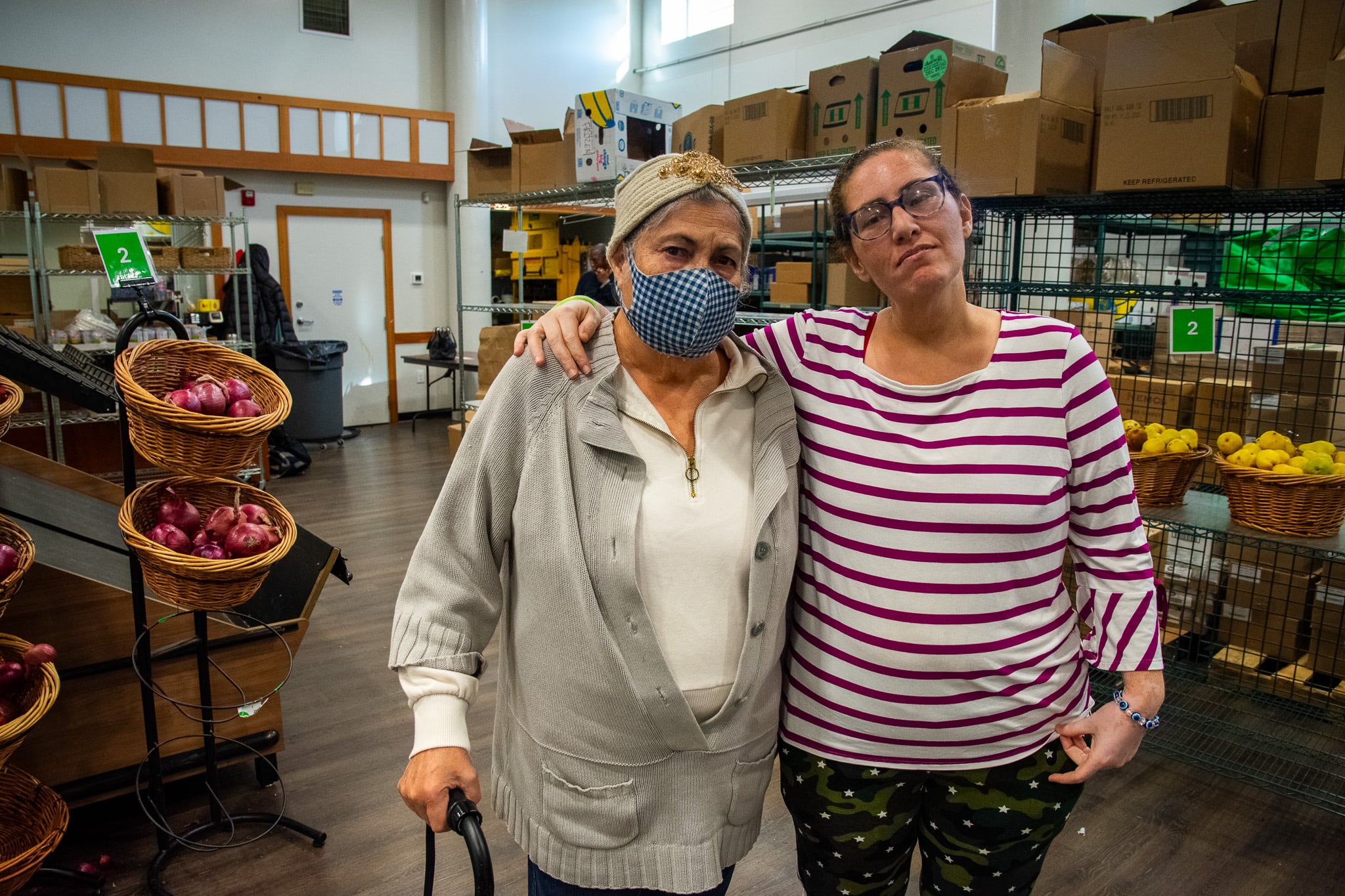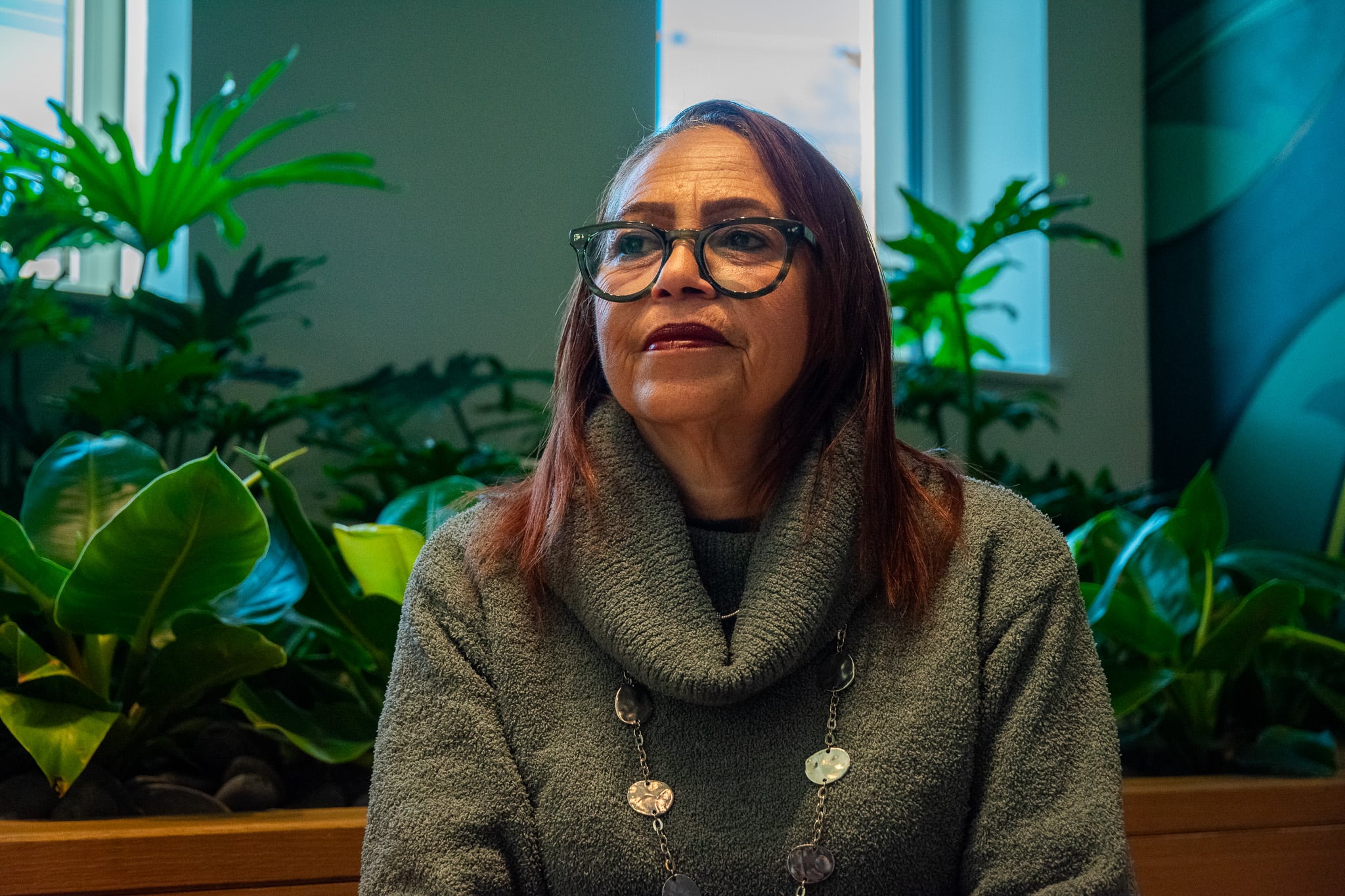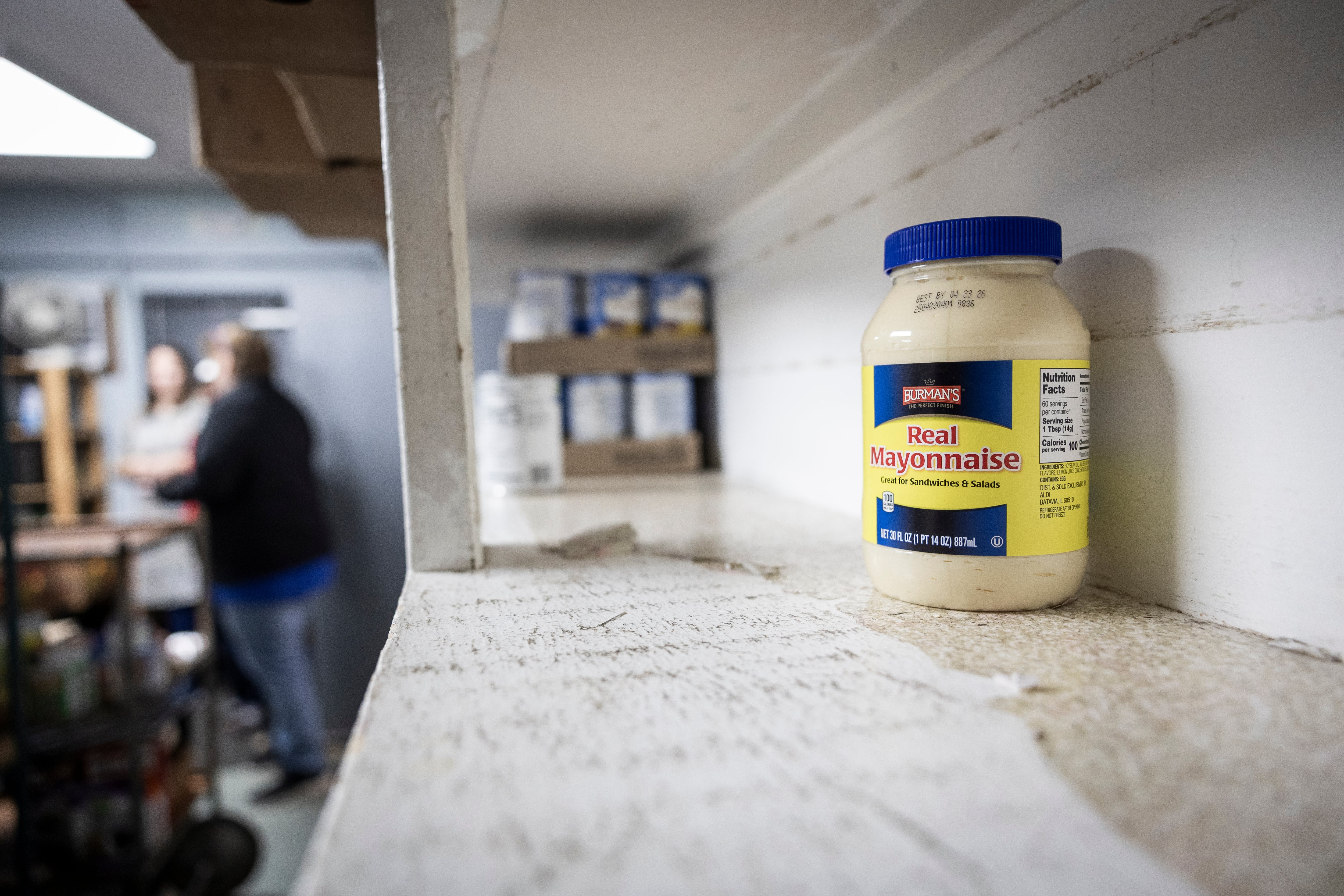This article was produced with the support of the USC Annenberg Center for Health Journalism as part of its 2025 Data Fellowship.
When Maria Guerrero was raising three kids on her own in Lynn, she visited a food pantry about once a month to make sure her family had enough to eat.
But it wasn’t until about three years ago — retired, living with her adult daughter, who has special needs, and facing the spiraling costs of everyday goods — that Guerrero registered for federal food assistance.
“You make $400 or $300 a week. You think you can buy food, pay rent, pay electricity, pay gas, pay all the bills in the house? You can’t afford it,” Guerrero, 77, a retired head cook, said earlier this month, clutching her cane as she sat beside her daughter and son at the Catholic Charities food pantry in Lynn.
The money Guerrero and her daughter get through the Supplemental Nutrition Assistance Program, or SNAP, the nation’s largest food aid program, only goes so far. Like many others, they turn to food pantries to fill the gaps.
But those critical safety nets are under mounting pressure.
Even before the sudden cutoff of SNAP benefits early this month, pantries were already stretched to their limits, more so than the public may understand.
The number of families struggling to find enough to eat spiked during the COVID-19 pandemic — and has remained persistently high ever since.
From the Berkshires to Cape Cod, Massachusetts’ network of independent food pantries was thrown into chaos at the beginning of November when the Trump administration paused SNAP assistance as the federal government shutdown dragged on.
Now entering the higher-demand holiday season, pantry directors wonder how long they may continue to see the lines that stretched around the block earlier this month.

Maria Guerrero and her daughter Flo, of Lynn, receive SNAP benefits and also rely on the Catholic Charities food pantry, where they are pictured Nov. 14, 2025. (Will Katcher/MassLive)
“We anticipate we’ll be seeing neighbors for months while they try to land back on their feet,” Pam Denholm, executive director of the Weymouth Food Pantry, said after the SNAP freeze. “If you’re not making enough for groceries and living that close to the line, maybe you’ve now diverted a car payment or utility payment to feed your family.”
In Massachusetts, one of the nation’s wealthiest states, more families like Guerrero’s were already seeking food assistance as the price of housing, health care and other essentials continued to rise.
Piled on are the typical additional expenses of this time of year: the first heating bills of the season, gifts and holiday meals.
So, while the federal aid cutoff this month was a rogue wave that sent food pantries reeling, the tide was already at their doorsteps.

A mother and son wheel a grocery cart through the Catholic Charities of Boston food pantry in Lynn, Nov. 14, 2025. (Will Katcher/MassLive)
The number of annual visits to the Sudbury Food Pantry — located in one of the wealthiest areas of Greater Boston — has roughly doubled since 2018.
On the outer stretches of Cape Cod, the Lower Cape Outreach Council saw visits to its food pantries rise from under 400 per month in 2019 to nearly 1,700 per month through October of this year.
In just September and October, Catholic Charities of Boston logged a 32% spike in families registering to use its food pantries in Dorchester, Brockton, Lowell and Lynn for the first time.
And the Greater Boston Food Bank, the region’s largest hunger-relief organization, said the 600 food pantries it supplies in Eastern Massachusetts still collectively receive about double the average number of visitors each month compared to pre-pandemic.
Food pantries are meant to fill the gaps in their clients’ food budgets. But their impact is “dwarfed” by the federal government’s food assistance system, led by SNAP, said Jonathan Tetrault, the vice president of basic needs at Catholic Charities of Boston.
The $100 billion program, still commonly known as food stamps, helped feed nearly 42 million people nationwide in fiscal year 2024.
In Massachusetts, more than 1 million people — one in six residents — receive SNAP benefits. Nearly a third of recipients are children, nearly a third have disabilities and more than a quarter are senior citizens, according to state officials.
The average monthly benefit nationally is $188 per person.
For nearly two weeks this month, the program’s status was in flux.

Workers and volunteers hand out food to people in line at La Colaborativa’s food pantry in Chelsea on Nov. 15, 2025. (Joseph Prezioso/AFP via Getty Images)
As the calendar flipped to November, Maria Torres, a Chelsea resident and grandmother, eyed her SNAP account with dismay.
The program typically provides her with $184 a month for groceries. Instead, Torres saw just 75 cents, the carryover she hadn’t spent in October. These days, it wouldn’t cover a pack of gum.
On Nov. 1, a Saturday, Torres wheeled her grocery cart down the block from her apartment to La Colaborativa, a leading support and advocacy organization for the area’s substantial Latino community.
A line formed in the chilly early morning air outside the nonprofit’s headquarters hours before staff would start distributing fresh produce, bread and other essentials. By the time the pantry opened, a train of hundreds of people snaked through the parking lot, down the block and around the corner.
“We were already in a bit of a crisis or approaching a crisis,” said State Rep. James Arena-DeRosa, a Holliston Democrat and former top Obama administration official for food and nutrition assistance in the Northeast.
“I mean, if you’ve got one in six people on SNAP, what does that say about your economy?” he asked.

Maria Torres, a longtime Chelsea resident, received her SNAP benefit nearly a week late at the beginning of November. She is pictured in Chelsea on Nov. 14, 2025. (Will Katcher/MassLive)
Demand at pantries surged in recent years
The pandemic disrupted the global economy and widened existing social inequalities. But even after the virus receded, economic uncertainty and inflation forced more families to tighten their budgets and seek help.
The number of Massachusetts residents turning to SNAP increased during and after the pandemic, from about 757,000 in January 2020 to almost 1.1 million as of this October.
In 2019, the food pantries in Eastern Massachusetts supplied by the Greater Boston Food Bank reported serving approximately 300,000 people per month on average.
When the pandemic set in, that number doubled. The pantries have continued to serve an average of 600,000 people per month for the past five years, according to the food bank.

A young girl places an onion in a grocery cart at the Catholic Charities of Boston food pantry in Lynn, Nov. 14, 2025. (Will Katcher/MassLive)
On Lower and Outer Cape Cod, the communities furthest from the mainland, visits to Lower Cape Outreach Council food pantries have steadily increased year by year.
The Cape suffers an acute and worsening housing shortage that has squeezed middle-class households, longtime residents and seasonal workers. When summer tourism winds down, many of the Cape’s working year-rounders struggle all the more.
In 2019, the council’s then eight pantries averaged 389 visits per month.
By 2022, when the organization opened its ninth pantry in Orleans, average monthly visits reached 685. Each year since has only brought more families. Through October of this year, the pantries were welcoming 1,681 people per month on average — a 332% increase in six years.
“The affordability for working-class people is getting so strained,” Gerry Desautels, the Lower Cape Outreach Council’s director of development, said. “People are working two to three jobs, and hunger is permeating the middle class.”
Families from dozens of towns have flocked to the Sudbury Food Pantry in growing numbers each year.
In all of 2018, the pantry logged just over 3,000 visits. By 2021, the number had climbed to more than 4,000. By 2023, it was over 6,200.
During the pandemic, people could visit the pantry as often as they needed, John Thomas, the pantry’s executive director, said.
But even after reverting to its pre-COVID limit of two visits per month in January 2024, the pantry still logged over 5,800 visits that year.
“We’re not looking at chronically economically disadvantaged families,” Thomas said. “We’re looking at people right on the margins. When there are factors beyond your control, you can’t just snap your finger and have a $100 bill appear under your pillow.”
Guerrero, the Lynn resident, retired more than a decade ago after working for years as a head cook at a nursing home.
Last year, she lost the home in which she raised her children to foreclosure. Guerrero and her daughter now live in a single-bedroom apartment in Lynn and are on the waitlist for public housing.
Their combined monthly SNAP benefits of about $450 are essential, Guerrero said.
“This is what the government and no one understands,” she said, slipping between English and Spanish. “Every day [comes] and you go to the supermarket and everything is changed … Whatever it is, it’s too expensive.”
A record week, ‘without a question’
In early November, with SNAP on pause and the Trump administration claiming it lacked funds to continue the program during the government shutdown, millions of Americans turned to their local pantry for food.
In Holyoke, where 43% of residents are on SNAP, one of the highest rates in the state, Margaret’s Pantry was serving twice as many families as it typically serves. The shelves emptied of vegetables, soup and other essentials. For the first time in her two-decade career, pantry director Brenda Lamagdeleine had to turn people away, instructing them to return the next day.

The shelves at Margaret’s Pantry in Holyoke emptied amid overwhelming demand for food on Nov. 3, 2025. (Douglas Hook/The Republican)
Visitors to the Food Bank of Western Massachusetts’s mobile food distribution sites increased 51% in the first week of November from their average number over the three months prior. Applications for a program offering free groceries to elders increased 69%.
The Weymouth Food Pantry, which registers a half-dozen new households in a normal week, received sign-ups from about 90 in the first week of November. It supplied more food when SNAP benefits were frozen than at the height of the pandemic, Pam Denholm, the executive director, said.
In suburban Maynard, about 15 miles west of Boston, the Open Table food pantry — which typically registers about 10 new households per week — signed up 80 in the first week of the month. The pantry usually delivers 1,400 frozen prepared meals weekly, but that week delivered over 2,200.
It was the pantry’s busiest week on record, said Alexandra DePalo, Open Table’s executive director. “Without a question.”
The Greater Boston Food Bank delivered more than 2.8 million pounds of food to pantries in the first week of November, an increase of 500,000 pounds over the same week in 2024.
Gov. Maura Healey and state lawmakers allocated additional money to support the pantries. The Massachusetts Emergency Food Assistance Program typically provides $4 million to food banks per month. Healey advanced an additional $4 million.
Read more: Mass. leads 25 states in suing Trump to preserve food assistance for 40M Americans
Healey also provided $13 million to support households that lost federal heating assistance during the shutdown, launched a “SNAP Resource Hub” to help people find support, and partnered with the United Way to establish a fund to help organizations serve people in need. By Nov. 17, the fund had raised $6.8 million.

Five-year-old Christian visits the TCM Food Pantry in Springfield with his mother on Nov. 4, 2025. (Douglas Hook/The Republican)
A ‘Herculean effort’ awaits
Though SNAP benefits have since been restored, many pantry directors — and the people they serve — still dread what happens next.
When SNAP funds finally flowed into her account nearly a week late, Torres, the Chelsea resident, wept. She had expected only a portion of the money to arrive, if at all.
“My tears came out of joy,” she said.
Still, Torres wonders whether SNAP will pay out as usual in the coming months.
Food pantries were already eyeing upcoming SNAP eligibility changes included in the spending package signed by President Trump on July 4. State officials said the new requirements mean 150,000 Massachusetts residents could lose some or all of their benefits.
Some pantry leaders also wonder how many of the new people they saw in line this month will need ongoing assistance.
But first, they must get through Thanksgiving.

Thanksgiving food waiting to be picked up at the Open Table food pantry in Maynard on Nov. 17, 2025. (Will Katcher/MassLive)
Many food pantries pinpoint it as their busiest week of the year. The volume of food served and the additional people families will welcome to their tables make it a pricey meal.
The Weymouth Food Pantry typically packages Thanksgiving bags for 700 families, including a turkey and “all the fixings,” Denholm said. This year, they are prepared to serve 1,100.
“We’re worried we won’t have enough. We’re worried we’ll have to turn folks away. We’re worried about the Herculean effort it takes to distribute this meal,” she said. “In Thanksgiving week, we’ll distribute the amount of food we may distribute in a normal month.”

Staff and volunteers at the Open Table food pantry in Maynard prepare Thanksgiving meals, which they will freeze and deliver for the holiday. (Will Katcher/MassLive)
Volunteers and staff at the Open Table pantry in Maynard spent last Monday preparing for what they expected to be their busiest Thanksgiving food distribution ever. They precooked and froze 1,300 Thanksgiving dinners and prepared another 400 ingredient kits for families who want to cook their holiday meals at home — 30% more of each than they distributed last year.
That was in addition to the 1,500 regular, non-Thanksgiving meals they were also preparing for the week.
By any metric, the surge of clients to the pantry early this month was record-breaking, DePalo, the executive director, said. She expected the trend to continue.
“People are just right on the edge,” she said.
If you purchase a product or register for an account through a link on our site, we may receive compensation. By using this site, you consent to our User Agreement and agree that your clicks, interactions, and personal information may be collected, recorded, and/or stored by us and social media and other third-party partners in accordance with our Privacy Policy.


Dining and Cooking